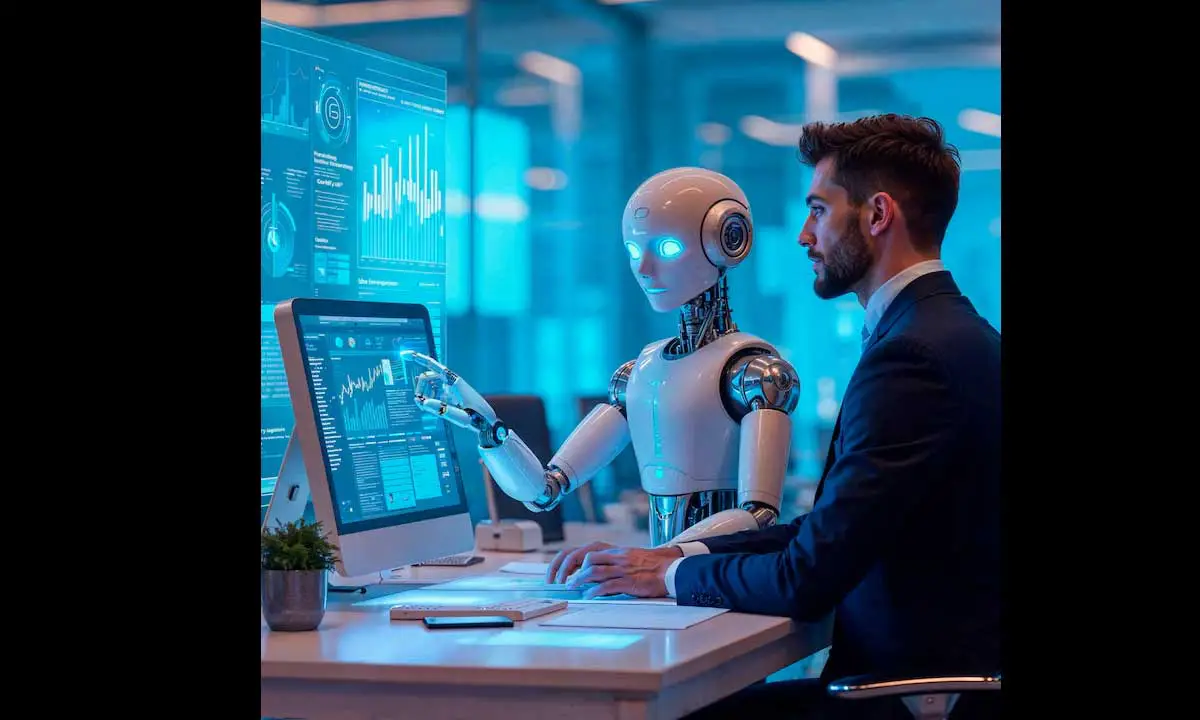Beyond Automation: How AI is Quietly Reshaping Work and Productivity in the Real World
Despite sweeping predictions about artificial intelligence revolutionizing the workplace and displacing millions of jobs, new evidence from Denmark presents a more nuanced — and surprising — picture. A comprehensive new study conducted by economists Anders Humlum and Emilie Vestergaard from the University of Chicago and the University of Copenhagen suggests that, while generative AI tools like ChatGPT are being widely adopted, their actual impact on wages and employment is negligible so far.
Titled “Large Language Models, Small Labor Market Effects,” the working paper analyzes real-world data from more than 25,000 employees across 7,000 Danish companies, tracking their experience with AI adoption between 2023 and 2024. Contrary to expectations of disruption, the study found no significant effect on either wages or employment — with average changes under 1% across the board.
AI Hype vs. Reality: A Gap Between Adoption and Impact
One of the most compelling insights from the research is the discrepancy between AI adoption rates and measurable labor market outcomes. While major headlines and industry think tanks have warned about automation replacing jobs, the data from Denmark paints a different picture: mass displacement is not happening—at least not yet.
“We were honestly surprised by the findings,” said co-author Anders Humlum in an interview. “AI tools are being used across many workplaces, especially in jobs that we would expect to be highly exposed to automation. But in terms of actual labor outcomes — wages, hiring, layoffs — the effect is extremely limited.”
The researchers specifically focused on 11 occupations traditionally seen as vulnerable to AI automation, including software developers, customer service representatives, bookkeepers, and accountants. These professions are known for involving routine or text-heavy tasks that generative AI tools like ChatGPT are particularly well-suited for.
Yet, despite widespread use in these areas, the tools did not significantly shift economic indicators. This poses questions about the real utility of AI in current job structures and whether the transformational impact of AI has been overstated — at least for now.
Adoption Is High — But the Time Savings Are Modest
According to the study, AI adoption within these vulnerable job categories was remarkably fast, with 64% to 90% of workers reporting regular usage of generative AI tools like ChatGPT or Copilot. Moreover, a significant portion of employees said that their companies encouraged AI tool adoption to increase productivity and modernize workflows.
Despite this widespread usage, the actual time saved by using AI tools was minimal. On average, workers only saved about 2.8% of their weekly work time—equivalent to roughly one hour per week. That’s far less than the lofty promises of 20%–40% productivity gains touted by some industry insiders and startup founders.
This suggests that while AI is being incorporated into daily tasks, it hasn’t yet become indispensable or transformative. Most professionals still rely heavily on human judgment, oversight, and existing workflows that AI hasn’t significantly altered.
New Tools, New Tasks: AI Adds Complexity, Too
Interestingly, the study also highlights a surprising side effect of AI adoption: the creation of new tasks for workers, including many who don’t directly use the technology.
Roughly 8.4% of workers were assigned additional responsibilities due to AI, such as reviewing AI-generated content, fact-checking outputs, or crafting better prompts to improve chatbot responses. In education, for example, teachers found themselves spending more time identifying AI-written homework or student assignments — creating an unexpected administrative burden rather than reducing it.
This underlines a recurring theme in technology integration: tools that promise simplicity often bring complexity, especially in the early stages of adoption. Maria Fernandez, a workplace technology consultant not involved in the study, explained it succinctly:
“AI tools don’t just automate tasks. They also require oversight, adaptation, and new layers of responsibility. In many cases, the net impact is small because time saved in one area is offset by time spent managing the tool.”
Who Benefits from AI Productivity?
Another important question raised by the Danish study concerns the distribution of benefits from productivity gains. Although companies reported mild efficiency improvements, the research found that only 3% to 7% of those gains translated into higher earnings for employees.
This suggests that the financial upside of AI productivity is largely accruing to employers, not workers. In other words, even if AI makes workers faster or more efficient, their paychecks aren’t getting noticeably bigger — at least not yet.
This insight aligns with broader concerns about the unequal economic impact of technological advancement, where capital owners and corporations often reap outsized gains, while wage growth for employees remains stagnant.
AI in the Lab vs. the Real World
This study contrasts sharply with a 2023 randomized controlled trial that found large productivity gains — as much as 15% — when workers used AI tools in carefully structured environments. According to Humlum, the difference likely stems from the nature of real-world jobs, which are far more complex and variable than laboratory simulations.
“Controlled experiments isolate tasks that are perfectly suited for AI,” Humlum explained. “But most jobs involve collaboration, ambiguity, and a mix of responsibilities that can’t be easily optimized by a chatbot.”
This raises a critical point for policymakers and business leaders: the promise of AI is real, but context matters deeply. Productivity gains will likely be uneven, delayed, and dependent on how well organizations integrate AI into their unique operational workflows.
Why Denmark? A Unique Labor Market with Global Lessons
While Denmark may seem like a niche case study, it offers valuable insights due to its high levels of digitalization, worker protections, and transparency in employment data. Danish firms are generally quick to adopt new technology, and the country’s comprehensive labor records make it an ideal environment for tracking emerging trends.
However, some caution is warranted when generalizing the findings. Denmark’s strong social safety nets, union protections, and relatively low income inequality may buffer workers from short-term shocks that could hit harder in countries like the U.S., where the gig economy is more prevalent and labor protections are weaker.
Still, the study provides a compelling early benchmark for how AI is affecting the labor market in a real-world setting. Rather than a tidal wave of job loss, the early phase of AI integration seems more like a gentle ripple, with significant long-term transformation still over the horizon.
Not All Sectors Are Immune
While the aggregate findings are minimal, some pockets of the labor market may already be feeling pressure. Freelance creative professionals — such as writers, designers, and illustrators — have reported increasing competition and downward pricing pressure due to the proliferation of AI-generated content tools like DALL·E, Midjourney, and ChatGPT.
For instance, freelance marketplaces are seeing a flood of low-cost AI-assisted services, which can undercut human freelancers and shift buyer expectations about pricing and turnaround time. While this trend wasn’t the focus of the Danish study, it’s a developing area that merits closer attention in future research.
As labor economist Thomas Chen put it:
“This study is an important first step, but it’s not the final word. The real disruption may still be coming as the tools improve and businesses figure out how to use them more effectively.”
The Next Phase: Ongoing Research and Policy Implications
As the field of AI rapidly evolves, ongoing research is essential. The Danish study focuses on 2023 and early 2024 — essentially the first wave of generative AI adoption. The next few years will be critical in determining whether these tools can deliver on their transformational promise or if their impact will remain incremental.
For policymakers, the findings provide an opportunity to pause and rethink alarmist narratives around mass unemployment due to AI. Instead, the data suggests a more strategic focus on workforce reskilling, digital literacy, and organizational change management — areas that are often overlooked in the hype.
Companies, too, should take note: simply deploying AI tools is not enough. The key lies in thoughtful integration, training, and redesigning workflows to make meaningful use of these technologies. Otherwise, the tools may simply layer more complexity onto already busy workdays without delivering the promised efficiencies.
Final Thoughts: A Slow-Burning Revolution
In a world saturated with bold claims about artificial intelligence changing everything overnight, the Danish study serves as a reality check. Generative AI is undoubtedly powerful, but its economic and social impact is more gradual and complex than many expected.
Yes, AI is reshaping work — but not through sudden displacement. Instead, it’s happening through micro-changes: modest time savings, new administrative tasks, subtle shifts in workflows, and an evolving balance of who benefits from productivity gains.
As we look ahead to a future where AI will continue to evolve, the most effective strategies will likely focus not on fearing displacement, but on embracing augmentation — and ensuring that workers, not just corporations, share in the rewards of this technological transformation.
Read Also:

